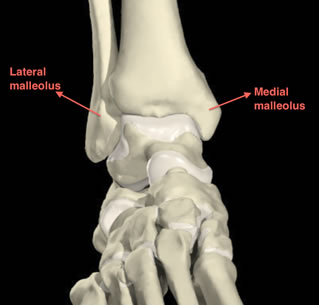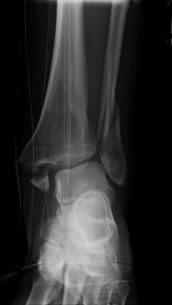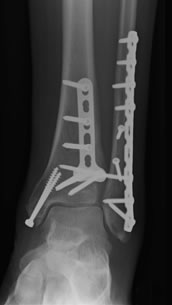in Foot and Ankle Surgery and Reconstruction

When you hear a doctor talk about an ankle fracture they are usually referring to fracture of the bony prominences on the outside and inside of the ankle. These bumps are called the lateral and medial malleolus. Occasionally the back portion of the ankle joint can fracture also (the back of the tibia), however this part is not felt from the skin, it is deep inside.
Sometimes it can be quite an innocuous injury. The commonest way to break your ankle is normally a twisting injury with your foot rolling inwards. It is the same way you might sprain your ankle except the force is greater causing the bones to break instead of the ligaments just spraining. It is the mechanism that gives characteristic fracture patterns on X-Rays. There are many other ways to break your ankle for example a direct blow such as during a football tackle or a fall from a height or a jump and landing awkwardly.
Pain is usually immediate and usually quite severe. The ankle swells up quickly and can deform. It is usually not possible to walk on however in some cases people do walk but with discomfort, not realising the ankle may be fractured.
Seek help by attending a local hospital. The most effective way to treat the immediate symptoms of pain and swelling is to rapidly splint the limb and take effective pain-killers. These are best administered by suitably qualified medical personnel. Once you are in hospital then a plaster cast splint can be applied which will give you enormous pain relief.
An X-Ray of the ankle is imperative. Sometimes the surgeon will get a more detailed CT (computerised tomography) scan, which can give you a 3D view of your ankle.

Operative treatment fixing the bones with plates and screws is usually advocated for more severe or unstable injuries, because if the ankle is simply treated in a protective cast the bones may move out of position. In the less severe or stable fractures they can be treated non-operatively in a plaster or boot and walking can be initiated quite early.

Normally your foot is held in a protective cast for 6 weeks. The cast is then removed and activities and weight bearing comfortably without the cast are initiated and gradually increased over a 2-3 month period. Return to full activity is variable but can be achieved by 3-6 months.
Most heal uneventfully however patients will “always remember” they have broken their ankle with intermittent symptoms such as very mild stiffness in cold weather. In some case unfortunately the fracture can lead to irreversible wear and tear (arthritis) in the joint. This can be treated in the future if problematic.